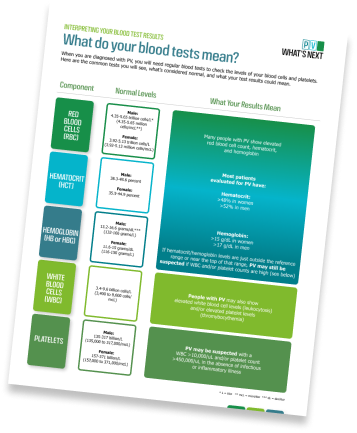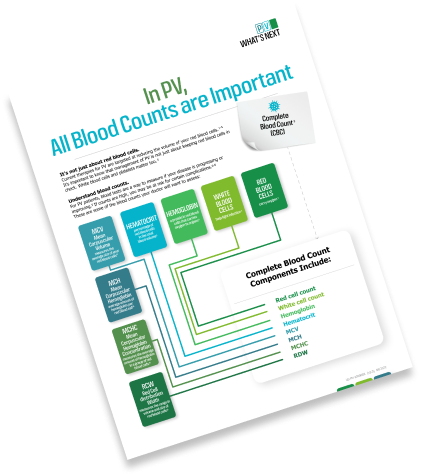Know What's Next
on your PV journey.
You've learned the facts and you understand the risks. Ready to take on what's next? Knowing what's next is important to your health and the decisions you and your doctor make about your future.
LIVING WITH PV
Simple lifestyle changes to help manage your day-to-day.
If you have PV, you can take steps to help yourself feel better. Here are some recommendations:5
In PV, All Blood Counts are Important
It's not just about red blood cells.
Current therapies for PV are targeted at reducing the volume of your red blood cells.1-4 It's important to know that management of PV is not just about keeping red blood cells in check. White blood cells and platelets matter too.5
Studies have shown that elevated white blood cell counts and platelet counts increase risk of blood clots that block veins and arteries.6-7 Elevation in white blood cells is also associated with PV evolving into serious cancers like myelodysplastic syndrome and acute myeloid leukemia.8
What's the goal for managing my blood counts?
The goal should be for you and your doctor to see hematocrit, platelet, and white blood cells counts all below specific levels for at least 12 weeks. Your doctor will also need to see significant improvements in disease-related signs (like an enlarged spleen) and other symptoms for at least 12 weeks. Additionally, the PV must have stopped progression, without any clotting events, and your bone marrow must show normal cell activity.5
Have you discussed the guidelines with your doctor?
Review the latest guidelines (updated 2024) to understand your options.10
NCCN Clinical Practice Guidelines in Oncology (NCCN Guidelines®)
WHAT ARE THEY?
The National Comprehensive Cancer Network® (NCCN®) is a not-for-profit alliance of 32 leading cancer centers devoted to patient care, research, and education.
The alliance creates guidelines (the NCCN Guidelines®) which recommend treatments for different cancers, including PV and other MPNs (myloproliferative neoplasms).9 These guidelines help doctors make treatment decisions based on your type of cancer as well as your risk level.
The NCCN also produces patient friendly versions of their guidelines so that you can understand the recommended treatment approaches for Polycythemia Vera. The patient guidelines for MPNs and Polycythemia Vera can be accessed here.9
In PV, you are considered low risk if you are younger than 60 years old and have no prior history of thrombosis (blood clots). High risk PV is defined as age 60 years or older and/or prior history of thrombosis.10,11
Low Risk
<
60
years of age
and
NO prior history of
Thrombotic
Event
High Risk
>
60
years of age
and/
or
prior history of
Thrombotic
Event10
NCCN makes no warranties of any kind whatsoever regarding their content, use or application and disclaims any responsibility for their application or use in any way.








